31 Days, 31 Lists: 2022 CaldeNott Titles

Okay! For those of you playing at home, you know the rules! Remember, a book that has a chance at winning a Caldecott must be created originally here in the States by an American illustrator. Now they can have been born here and have moved away, or they can have American citizenship later in life. Them’s the rules. Problem is, we just have a slew of marvelous books out there that are disqualified because their creators are inconveniently not from around these here parts. Today, we salute them! Not Caldecotts but CaldeNOTTS.
Here then are the books I think could win it all, if only they could.
Oh, and if you’re interested in previous years and their CaldeNotts take a gander at these:
2022 Caldenott Contendres
Book of Questions / Libro de Las Preguntas by Pablo Neruda, ill. Paloma Valdivia, translated by Sara Lissa Paulson
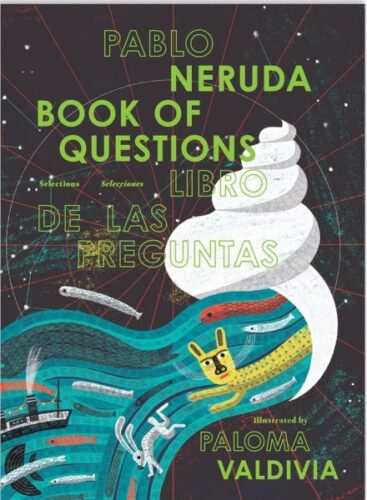


Neruda’s last great work of poetry is reimagined for kids in this sumptuous collection. 70 questions of the original 320 are presented thematically to kids, and the results are ridiculous thoughtful, and often unanswerable. Oo. Considering how much time and effort and work it often takes to find decent children’s poetry in a year, I was just blown away when I was sent this book at the beginning of the year. It’s so clever in its construction. Neurda’s Book of Questions is taken and the questions are selected, split up, and placed together thematically. It’s a smart way of presenting them, and the result really is more poetic than anything else. Some are philosophical, some practical, and all will make kids think. Meanwhile, it’s on today’s list because artist Paloma Valdivia, who is Chilean like Neruda was, just goes to town with the art. My particular favorite image came when Valdivia interpreted rice like teeth. Be careful not to miss any of the marvelous gatefolds, which are almost hidden throughout the book. I often had to go back and make certain that I wasn’t missing anything. Extra points for the fact that the book is bilingual too. This is a beauty, truly.
ADVERTISEMENT
ADVERTISEMENT
The Depth of the Lake and the Height of the Sky by Kim Jihyun

A wordless South Korean import celebrates nature, wilderness, and traipsing about on your own. Using a technique of writing ink and a “slow-dry blending medium”, it’s funny to think that when you get right down to it, this is a black and white picture book. Such things are rare on the market when they’re homegrown, so I wasn’t surprised to hear that this came from overseas. When Jules Danielson featured this book on Seven Impossible Things Before Breakfast she mentioned that its original title in Korean was merely “Last Summer”. So somewhere along the lines, someone at Floris Books had the wherewithal to give this book this luscious, loving title. As someone who, as a kid, loved bumming around woods by myself, this book tapped into that feeling beautifully. My favorite moment comes after the kid has been swimming and he simply lies on his back, on a dock, on a sunny day. You get this two page spread of what it looks like when the sun is directly ahead that is this remarkable example of how human hands can paint ink to look like light. It’s marvelous. If I could frame any sequence from this book, it would be that one. A gentle, wonderful example of accomplished wordless storytelling.
Elephant Island by Leo Timmers, English text by James Brown

Belgian author/illustrator Leo Timmers has this way about him. His art, which is distinctive and unmistakable, always looks to my eye like it’s just the teeniest, tiniest bit three dimensional. I don’t know how else to describe it. Let’s take Elephant Island as an example. It’s something about how shiny he makes this elephant’s skin (look at that cover and admire all the ways he makes the sun shine off of the trunk, the folds of the flaps of the ears, the toenails, etc.). Or maybe it’s that contrast between the enormous, almost cartoonish eyes and the layered body. In this book, Timmers taps into something I’ve always enjoyed in picture books: the idea of creating a space for you and your friends to hang out together. Stories like this always make me happy. A lonely kid can derive a great deal of pleasure from this story of an elephant that finds himself stranded on the world’s smallest “island” (it’s just a rock, barely wide enough for him to stand on) and then consequently engineers his way into the construction of an entire edifice on that single point. Budding Frank Lloyd Wrights will marvel at the different ways in which crashed boats (anyone who attempts to rescue the elephant inevitably finds their own boat flotsamed and jetsamed) can become floors, walls, and more. The sheer inventiveness of the entire endeavor is to be commended. Come for the elephant. Stay for his island.
The Flamingo by Guojing

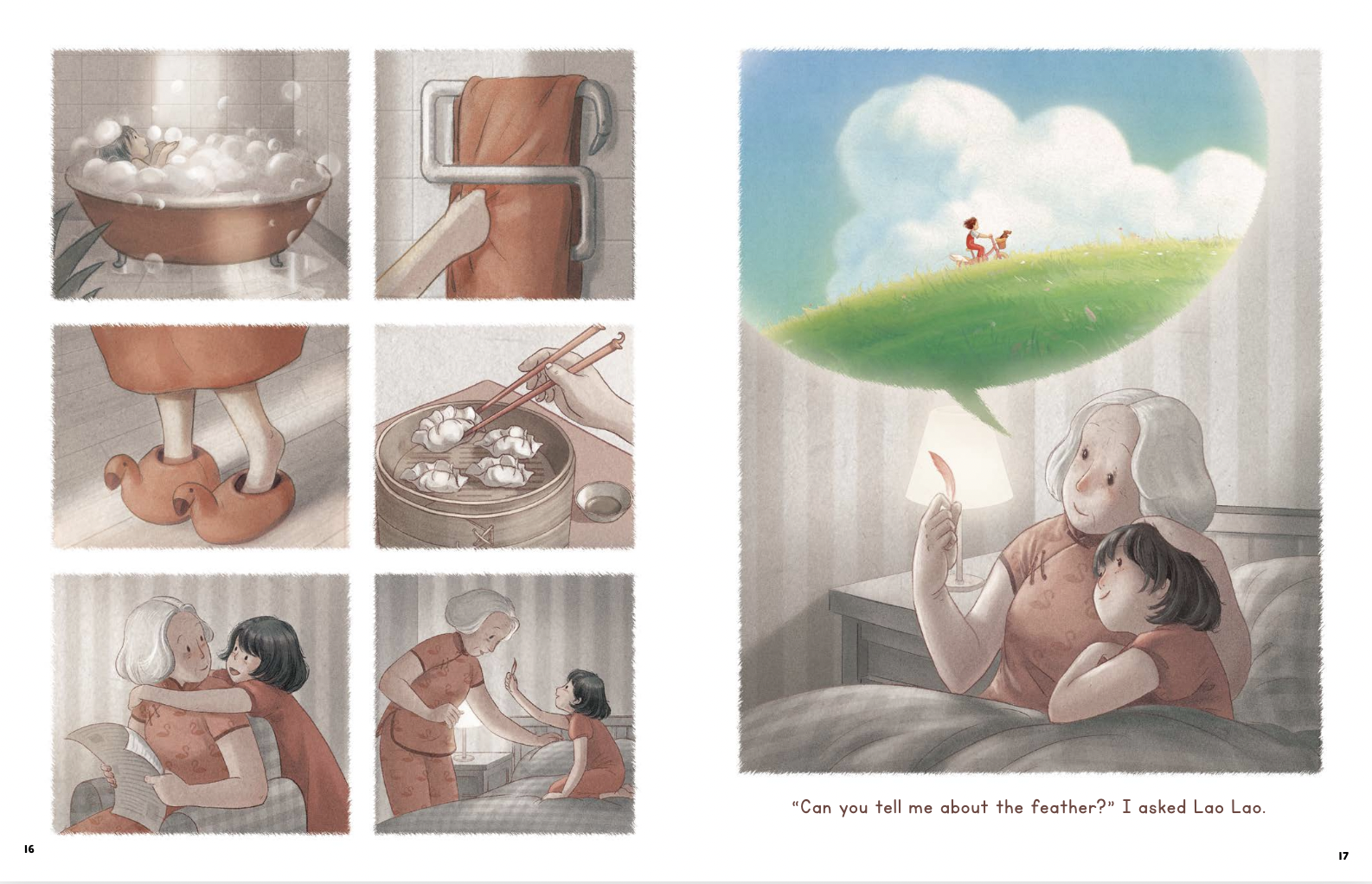
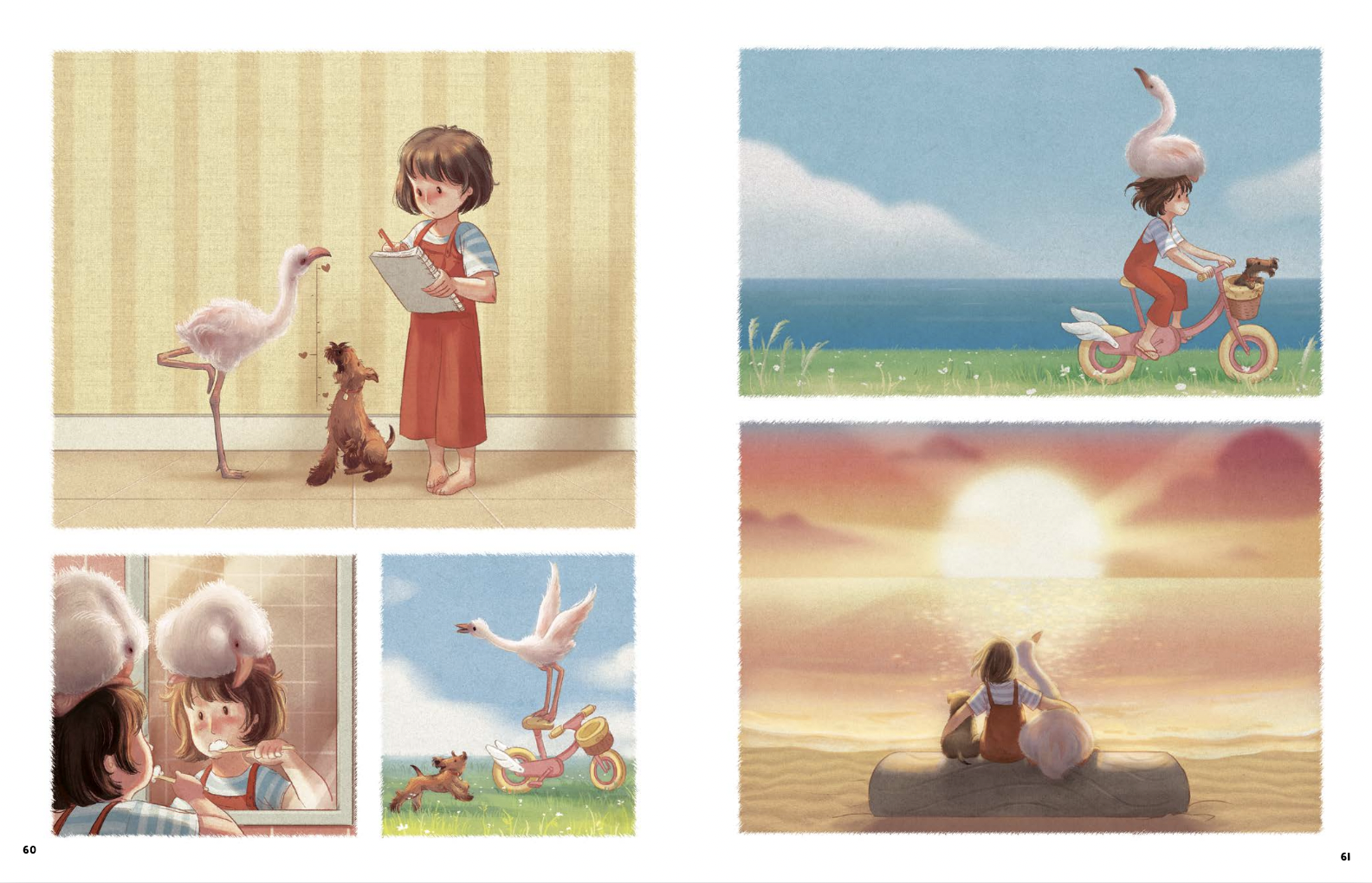

While visiting her grandmother, a child hears story after story about a girl long ago that raised a flamingo chick from an egg. An artful, nearly wordless tale with the feel of a Miyazaki film. Utter gorgeous gorgeousness. Guojing’s the same creator that brought us The Only Child years ago. That story was just soaked in sadness. This one is far happier. I was surprised to see that the book had any text at all. Most of it is wordless, and since Guojing is a master at the sequential wordless sequence, it made sense to assume that the whole book would be like that. Oh, but I loved the storyline. Those sunsets. And though I believe a newly hatched flamingo chick could never, not in a million years, be quite as cute as this one, I loved watching it grow up. This is complete and utter wish fulfillment and I am here for it!
The Last Rainbow Bird by Nora Brech, translated by Floris Books


What a pleasure. In March of 2022 I found myself at the Bologna Book Fair, wading through thousand upon thousands of picture books from all over the world. In the course of my travels I wrote a blog post called This One’s for the Publishers: Books You Should Bring to America. The piece happens to mention this charming Norwegian publication called Den store fuglejakten. I had no idea, based on just flipping through the images, what it was about (my Norwegian ain’t what it could be) but it was plain to see that the art was stellar. Strange and ridiculous and marvelously colored throughout. You can imagine my joy when I found the book published here in the states in September! Utterly lovely from start to finish, the plot turns out to be about two girls who set off on a quest to aid their friend Professor Feather. He’s saving all the rare birds, you see, but one little rainbow bird (who looks oh so forlorn and plain) doesn’t have a mate. Thus, the girls go to find another rainbow bird, wherever it might be. The lovely susurrations of colorful birds are worth the price of admission alone. A wonderful import.
Night Lunch by Eric Fan, ill. Dena Seiferling
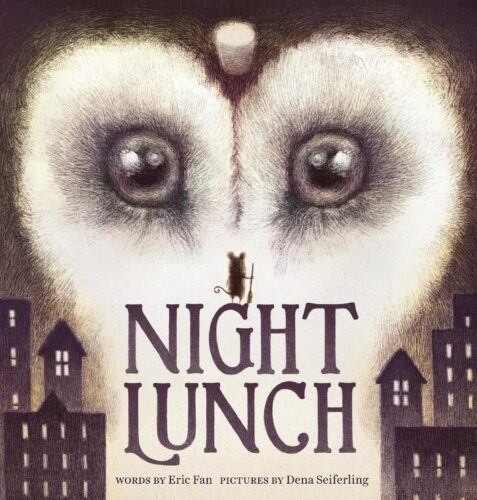
“Clip clop, a midnight moon / The night lunch cart rolls in.” Gently rhythmic wordplay accompanies the story of a kindly owl, the animals that feast at its lunch cart, and the hungry little mouse it befriends. Lovely and memorable. Under normal circumstances I’m no fan of picture books in which predators befriend their prey (Miss Spider always kind of irked me) but I may have to give a pass to this particular beauty. How could I resist? I’ve always liked Seiferling (a resident of Canada) and her style, but apparently if you set her books at night they get this extra added kick. It’s funny. There’s a rhythm to it, but it doesn’t rhyme. I love what the art does with light here. It’s also a great book for any child who has a parent that’s a night worker, it occurs to me. A fortuitous pairing results in a strangely comforting little book.
Paradise Sands by Levi Penfold

ADVERTISEMENT
ADVERTISEMENT
As God is my witness, I didn’t know how to categorize this book so I think I’ll have to slot it under “folktales” even though it’s clearly an original creation. But the tone, man, the tone! We just don’t see a lot of truly haunting picture books in a given year. This one has all the hallmarks of a book that someone will buy for a child, the child will read and reread for years, and it’ll embed itself in the deepest folds and crevices of that child’s brain. Now I’m no fan of sepia, but that’s only because folks don’t know how to use it. Penfold here, an Australian, knows what he’s doing. I’m assuming this is taking place in the outback, but on a first read I figured it was somewhere in the more barren parts of the west. The people featured in this book look scoured. Like the wind and the sand and the dirt have worn them down in small ways. The story is fairly classic, though contemporary. A girl and her three brothers are driving to visit their mother in the hospital. Along the way they sing an old folksong that turns out to be terribly prophetic. The brothers are quickly enchanted and transformed and the daughter must obey the rules of the Teller and neither eat nor drink nor take any food or water for three days to save them. The Teller is represented as a lion that looks as if he were dipped in a strange, deep sadness. The ending is bittersweet as the girl both succeeds and fails. Penfold invokes all the best elements of classic fairytale literature, and the words are told just perfectly. If you need something beautiful and odd to give to a child, you could hardly do better than this.
Pina by Elif Yemenici, translated by Sydney Wade



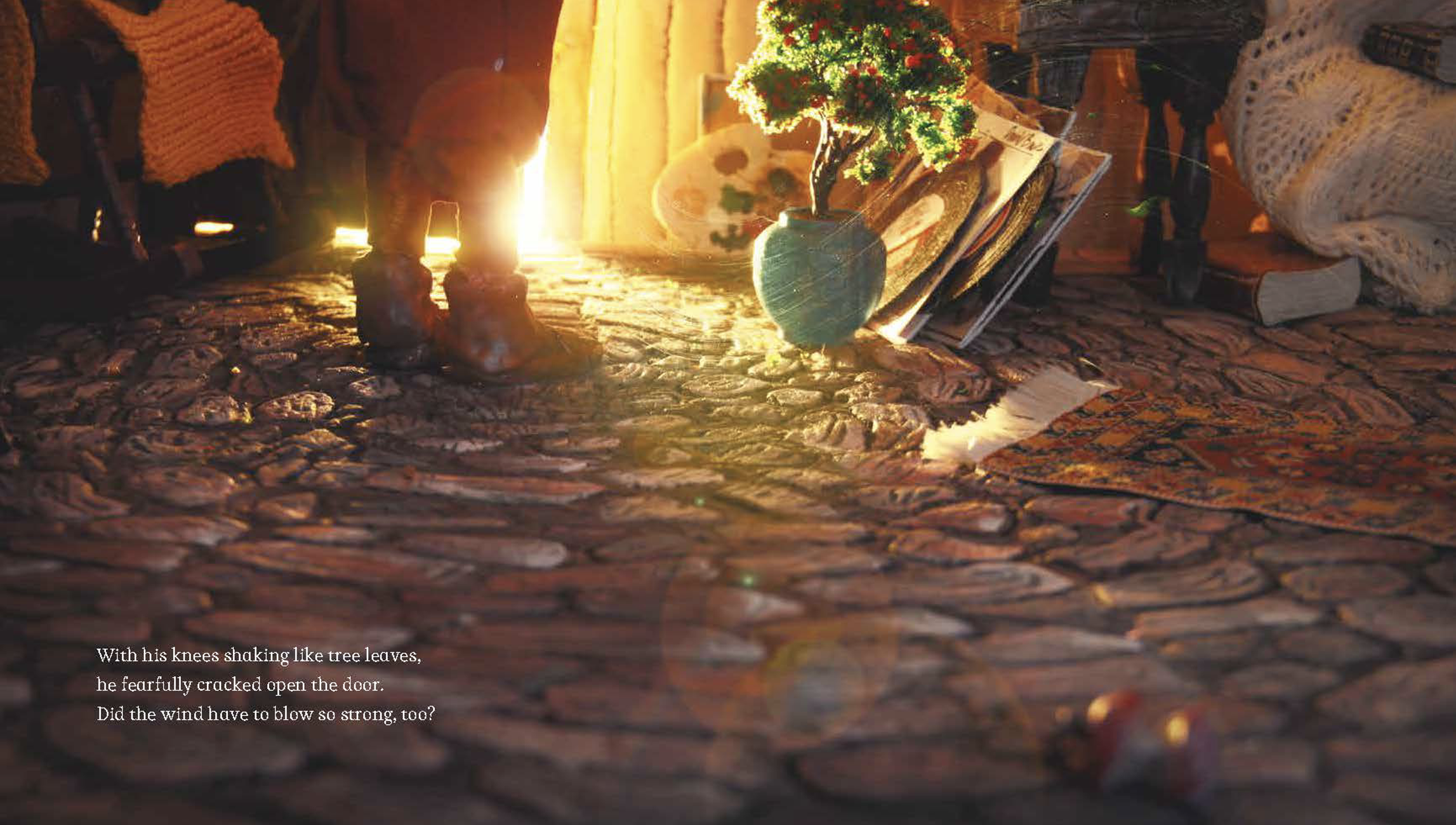
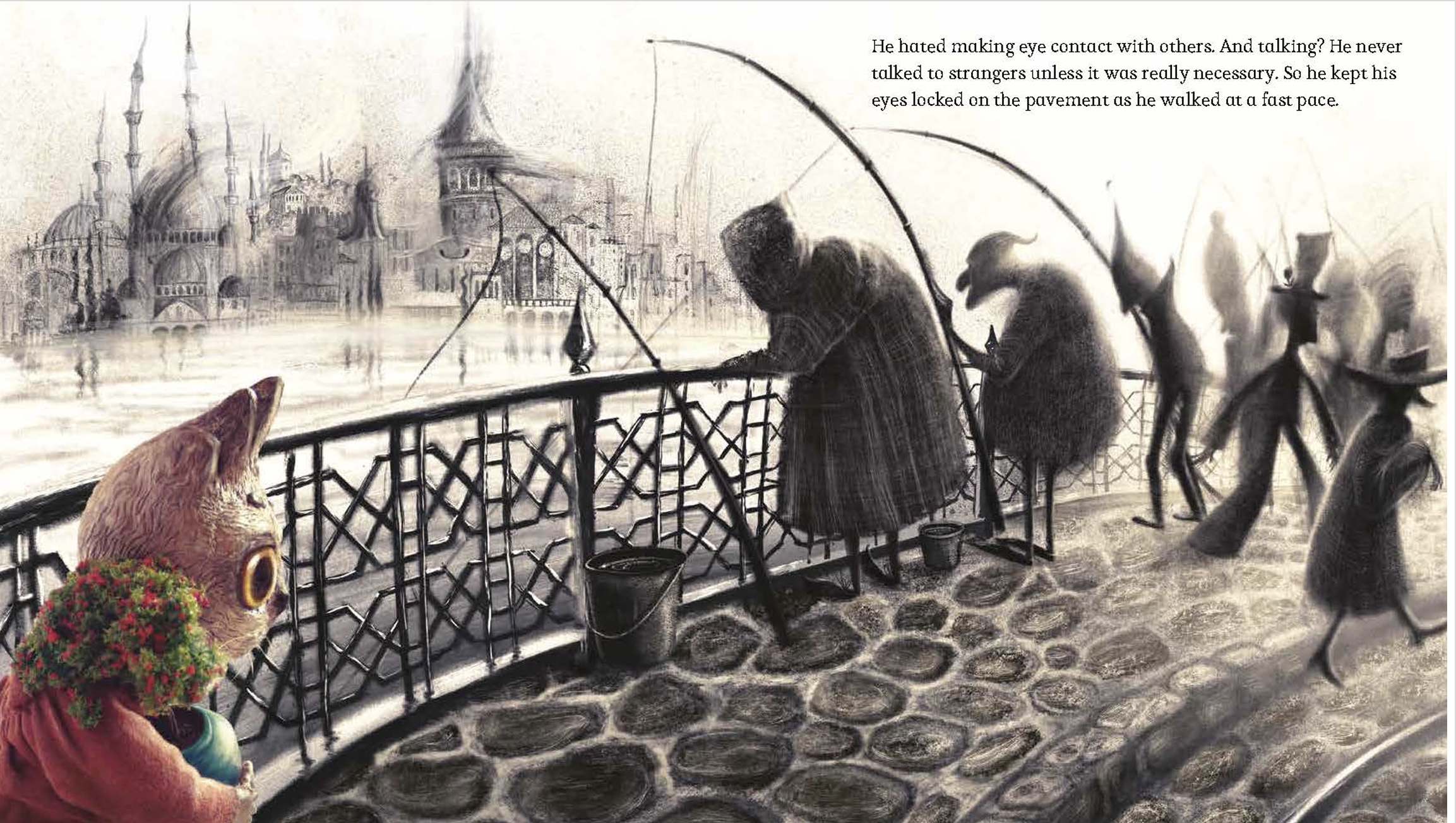

Pina lives in a tiny, warm house that contains everything he could ever need. But when he realizes he’s out of cheese, shopping turns into a walk into the unknown. Label this one a delightful Turkish import about trying new things. It is remarkably difficult for me to resist models. I don’t know why this is. Maybe it was all those Bagpuss shorts I watched as a kid on Nickelodeon. Whatever the case, when a picture book uses models ala Red Nose Studio I’m enthralled. It’s not merely the logistics of the enterprise (though those are fascinating) but rather how perfectly you can create a little world within the covers. Pina proves to be an excellent example of this! At the beginning you have to understand why Pina, a big-eyed little cat-like person, would prefer staying inside in his cozy little home, rather than venturing out into the big scary world. So Yemenici fills the rooms with delightful clutter. When I think how long it must have taken to construct each and every last one of those little leather-covered books, or the tiny paintings on the wall, or the miniscule Velvet Goldmine records on the floor (I’m not kidding about that) the mind boggles. Even the light is this soft, cozy, endearing glow. The outside world, in contrast, comes across as black and white, harsh and scary. And part of what I find so amazing about this is that even when Pina becomes more comfortable with talking to new people and seeing new things, that doesn’t mean everything black and white has changed. It just means that at the end, sitting on a bench next to the sea, watching the sunset, there’s a bit more color out there than there was before. This is a masterful bit of work and it fills the Baek Hee-na shaped hole in my heart where a new book of hers should be. I wouldn’t miss it, if I were you.
Shuna’s Journey by Hayao Miyazaki, translated by Alex Dudok de Wit
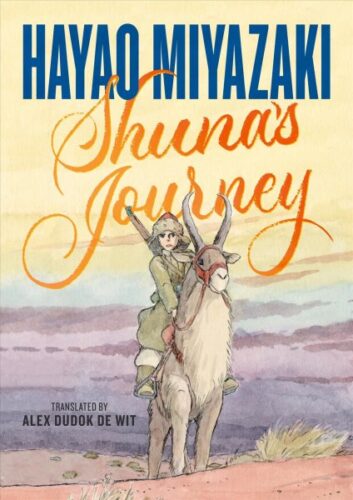
It’s absolutely baffling to me that we received, this year, a fantastic Miyazaki (yes, THAT Miyazaki) graphic novel with all the hallmarks of one of his films and yet the publicity? Almost nil. The story behind this book is nearly as fascinating as the book itself. Apparently this title dates back to 1983 (though it feels fresh and new when you first encounter it). It was published a full two years before Studio Ghibli was established. The story, according to Miyazaki himself in the Afterword, is based on an old Tibetan folktale called “The Prince Who Turned Into a Dog”. In this version, a young man named Shuna is the prince of a poor land. Determined to find a mysterious grain that could feed his people, he sets off on a quest to find this miraculous food. Along the way he runs into slavers, slaves, and an economy based on humans for grain. It actually reminded me of this year’s film Nope a little bit at times, as well as a lot of other Miyazaki films. The book takes an unexpected turn halfway through when its focus shifts from Shuna’s point of view to the formerly enslaved Thea. But the reason I’m placing it on today’s list is that it’s a shocking beautiful book through and through, thanks in large part to the incredible watercolors inside. Apparently this has been popular in Japan since the early 80s, and the translator, Alex Dudok de Wit, speculates that its been ignored by scholars because it had never been translated before. Well, problem solved! One of the more amazing comics of the year. Don’t let it pass you by.
The Tale of the Tiny Man by Barbro Lindgren, ill. Eva Eriksson, translated by Julia Marshall

Hey, that’s a nice heart you’ve got there. Mind if I rip it out of your chest? You don’t mind? Well, I’m feeling a little sleepy so why don’t I just let this book do it for me instead? By all accounts this is a 1979 classic work of Swedish children’s literature. It was re-illustrated by the highly talented Eva Eriksson in 2010, and now at long last we get to see it here in the States in 2022. Mind you, this book truly does deserve its “classic” status, since there’s not a thing about it that has aged. I compare it to a picture book version of It’s a Wonderful Life, not because there are any suicide attempts or angels at work (though the tiny man does bear a bit of a resemblance to Clarence) but because the first half of this book is SO sad, and is then redeemed entirely by the second. Our hero is a lonely, tiny man. Other men trip him on purpose and set their mean dogs to bark at him. At night he cries to himself and wonders, “Why doesn’t anyone like me? I’m a kind person.” Into his life comes a dog. Over time, the two not only bond but the tiny man adopts it. All is well until a neighbor girl comes by and the dog likes her too. This book taps so perfectly into that feeling kids get when they have to share their friends. And let me tell you, NOBODY draws a smug man smiling at making another man miserable quite as well as Eriksson. You can import more of her books into this country anytime, folks.
Eager to read other lists this month? Then be sure to check out the following:
December 1 – Great Board Books
December 2 – Picture Book Readalouds
December 3 – Simple Picture Book Texts
December 4 – Transcendent Holiday Picture Books
December 5 – Rhyming Picture Books
December 6 – Funny Picture Books
December 7 – CaldeNotts
December 8 – Picture Book Reprints
December 9 – Math Books for Kids
December 10 – Gross Books
December 11 – Books with a Message
December 12 – Fabulous Photography
December 13 – Translated Picture Books
December 14 – Fairy Tales / Folktales / Religious Tales
December 15 – Wordless Picture Books
December 16 – Poetry Books
December 17 – Unconventional Children’s Books
December 18 – Easy Books & Early Chapter Books
December 19 – Comics & Graphic Novels
December 20 – Older Funny Books
December 21 – Science Fiction Books
December 22 – Fantasy Books
December 23 – Informational Fiction
December 24 – American History
December 25 – Science & Nature Books
December 26 – Unique Biographies
December 27 – Nonfiction Picture Books
December 28 – Nonfiction Books for Older Readers
December 29 – Best Audiobooks for Kids
December 30 – Middle Grade Novels
December 31 – Picture Books
Filed under: 31 Days 31 Lists, Best Books of 2022
About Betsy Bird
Betsy Bird is currently the Collection Development Manager of the Evanston Public Library system and a former Materials Specialist for New York Public Library. She has served on Newbery, written for Horn Book, and has done other lovely little things that she'd love to tell you about but that she's sure you'd find more interesting to hear of in person. Her opinions are her own and do not reflect those of EPL, SLJ, or any of the other acronyms you might be able to name. Follow her on Twitter: @fuseeight.
ADVERTISEMENT
ADVERTISEMENT
SLJ Blog Network
One Star Review, Guess Who? (#202)
Exclusive: Giant Magical Otters Invade New Hex Vet Graphic Novel | News
Parsing Religion in Public Schools
Take Five: LGBTQIA+ Middle Grade Novels
ADVERTISEMENT








Is “gross books” a new category? That’s awesome.
What category did you have to drop for it?
Ahhh. You are a sharp-eyed spotter. Yes, unfortunately it doesn’t look like I did a good job of keeping track of the great bilingual picture books of the year. Next year I’ll try to do better. We’ll see how the gross books fare then.